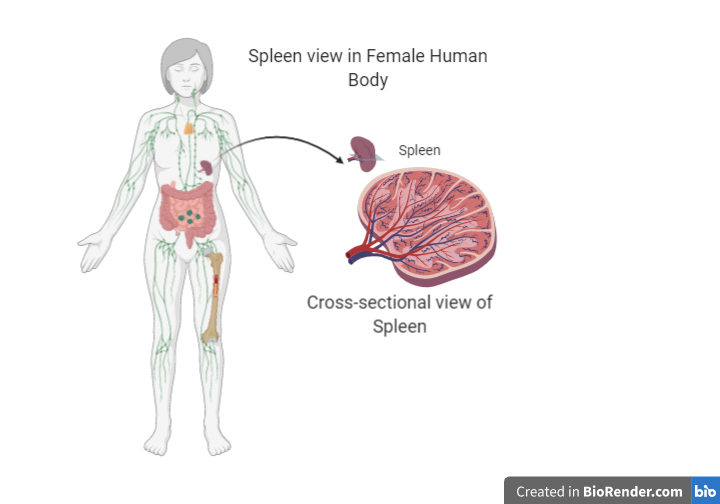
Which one of the following human organs is often called the ‘graveyard’ of RBCs?
A. Kidney
B. Spleen
C. Liver
D. Gallbladder
Answer
566.1k+ views
Hint: The RBCs have a very short life span. They undergo haemolysis after some days. This happens in an organ that acts as a blood filter and comprises immune cells of the blood. Also, this organ acts as a large lymph node.
Complete step by step answer: The Red blood cells or RBCs are the hemoglobin carrying cells that are disc-shaped. They circulate throughout the body providing oxygen to various other cells. The RBCs lack major cellular organelles like the endoplasmic reticulum, mitochondria, nucleus, etc. Thus, they do not have any of their energy sources to sustain a longer life span. Therefore, they survive just for around 120 days.

When they are about to die they attract auto-antibodies. Auto-antibodies are immune components that act against the body’s cells. Once the auto-antibodies attach to RBCs they initiate a cascade effect. The macrophage cells of the immune system attach to suicidal RBCs. After this, the macrophages lyse the RBCs in the liver and spleen. This is known as haemolysis. The product of hemolysis is a large waste of red blood cell debris. This needs to be removed from the body’s circulation to prevent any blockage. The spleen is the main organ that removes the dead red blood cells from the bloodstream.
Hence, it is called the ‘Graveyard’ of RBCs. So, the right answer is option B.
Note: The spleen acts as a synthesis organ for RBCs in the fetal stage. It acts as the center of production of all types of blood cells during fetal life. Also, in the adult stage, the spleen functions to provide an active immune response in case of infections. It filters the blood from cellular debris and foreign particles including pathogenic microbes.
Complete step by step answer: The Red blood cells or RBCs are the hemoglobin carrying cells that are disc-shaped. They circulate throughout the body providing oxygen to various other cells. The RBCs lack major cellular organelles like the endoplasmic reticulum, mitochondria, nucleus, etc. Thus, they do not have any of their energy sources to sustain a longer life span. Therefore, they survive just for around 120 days.

When they are about to die they attract auto-antibodies. Auto-antibodies are immune components that act against the body’s cells. Once the auto-antibodies attach to RBCs they initiate a cascade effect. The macrophage cells of the immune system attach to suicidal RBCs. After this, the macrophages lyse the RBCs in the liver and spleen. This is known as haemolysis. The product of hemolysis is a large waste of red blood cell debris. This needs to be removed from the body’s circulation to prevent any blockage. The spleen is the main organ that removes the dead red blood cells from the bloodstream.
Hence, it is called the ‘Graveyard’ of RBCs. So, the right answer is option B.
Note: The spleen acts as a synthesis organ for RBCs in the fetal stage. It acts as the center of production of all types of blood cells during fetal life. Also, in the adult stage, the spleen functions to provide an active immune response in case of infections. It filters the blood from cellular debris and foreign particles including pathogenic microbes.
Recently Updated Pages
Why are manures considered better than fertilizers class 11 biology CBSE

Find the coordinates of the midpoint of the line segment class 11 maths CBSE

Distinguish between static friction limiting friction class 11 physics CBSE

The Chairman of the constituent Assembly was A Jawaharlal class 11 social science CBSE

The first National Commission on Labour NCL submitted class 11 social science CBSE

Number of all subshell of n + l 7 is A 4 B 5 C 6 D class 11 chemistry CBSE

Trending doubts
Differentiate between an exothermic and an endothermic class 11 chemistry CBSE

10 examples of friction in our daily life

One Metric ton is equal to kg A 10000 B 1000 C 100 class 11 physics CBSE

Difference Between Prokaryotic Cells and Eukaryotic Cells

1 Quintal is equal to a 110 kg b 10 kg c 100kg d 1000 class 11 physics CBSE

State the laws of reflection of light




